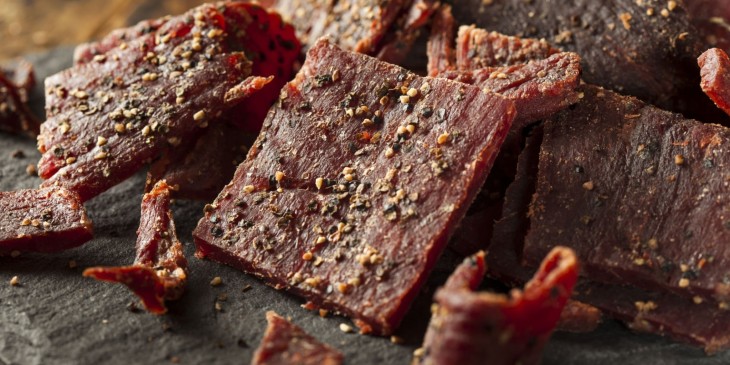
Publish date : January 27, 2023
Categories: Biltong jerky
Tags: air dried meat, Biltong jerky, fatty biltong, Mufasa Biltong
Don’t we all love snacking throughout the day? But we often make unhealthy snacking choices. Today we will talk about a protein-rich traditional meat snack of South Africa – Biltong. This meaty, satisfying, and nutrient-dense snack will leave you wanting more. No wonder it is gaining popularity faster than ever.
If it is your first time hearing the name, then let us help you get a better understanding. Let’s begin by figuring out what biltong is. Biltong is an extremely popular dried meat snack and a staple in the diet of most South Africans. It is an intensely flavourful heritage snack with an oh-so-interesting origin story. Eating dried meat as a snack in many cultures is common. These snacks are known by different names in countries, like American beef jerky or Italian prosciutto. But the unique drying process makes Biltong stand out in the crowd. The distinct flavour and texture can be attained only by following the traditional preparation method.
How is the Mufasa Biltong in Wangara prepared?
This thinly sliced, cured meat originated in the Southern part of Africa, like Zimbabwe, Botswana, and South Africa. It tastes almost like beef jerky but is still very different. It has the closest similarity to beef jerky, but still, its unique flavour gives it a whole new dimension. Although Biltong has been traditionally eaten in South Africa forever, it was never mainstream like beef jerky. But slowly, Biltong is giving tough competition to the already popular beef jerky. And why not? Biltong jerky is prepared using less amount of preservatives compared to beef jerky
Let’s take a peek into the mind-blowing history behind the origin of Biltong
Biltong jerky will blow your mind with its flavour fullness. However, we bet that this fatty biltong will taste even better once you know its origin story.
The natives used to salt and hand-dry the meat to carry along their long-distance journeys. The weary travellers would get pepped by having these on their way.
The drying and curing of meat started in South Africa 400 years ago. Dried and cured meat can be anything from beef to pork and ostrich to antelope. This is why when we say biltong jerky, we refer to the ones made traditionally. South Africans have been rubbing with salt and preparing air dried meat for ages, and now the rest of the world is catching on to the trend.
Want to know more? We Give You 15 interesting facts about Biltong jerky
- You may wonder where the name Biltong comes from. “Bil” means rump, and “Tong” means strip in Afrikaan vocabulary. This explains the origin behind the interesting name.
- Before the European and the Dutch arrived in Africa around 17 the century, the natives only used to rub the meat with salt and air dry it. They started experimenting by adding vinegar and spices like cloves, coriander, pepper, etc.
- Although it’s a traditional meat snack in South Africa, it is very new to the rest of the world. Biltong jerky has never been commercialised at this scale.
- Biltong has some incredible stories associated with its origin. According to some folklore, travellers migrating from one place to another would place the strips under the saddle. The chafing of the whole day would make the meat tender, and the sweat of the horse would spice it up.
- Biltong can be made from any meat, but beef is most commonly used. The meat cuts used to make this meaty snack is usually silverside, topside, rump, or eye fillet.
- Besides beef, the most used game for making Biltong is pork and kudu. Kudu is an antelope inhabiting the forests of East and South Africa. Apart from these, buffalo, impala, springbok, and other animals are often used to make Biltong.
- Fish biltong, known as “Bokkoms”, originated in the 17th century on the Western coast of Cape province. Young mullet fish is used to prepare this delicacy.
- The traditional process was to dry the meat in the open air in winter. The ideal temperature is between 20-25°c, which toughens the meat.
- Authentic biltong only had black pepper, coriander vinegar, and brown sugar in it. However, today, various flavours are available, like chilli biltong, peri peri biltong, and Barbecue biltong.
- If you wish to bring biltong to Australia, it cannot be made with pork. Moreover, it has to be commercially made and sealed correctly.
- It is interesting to know that importing biltong in the USA is strictly prohibited. However, there is no law prohibiting the manufacturing of Biltong jerky.
- For anyone looking for a healthy snack, biltong is one good find. When made authentically, it contains zero additives or preservatives. Not just protein, it is also an excellent source of Vit B12, Zinc, and creatine.
- Biltong is not limited to a single style. The variety is quite huge, from wet biltong to drier and chewier versions and from fatty biltong to lean ones.
- Never mistake the biltong for beef jerky. They are completely different. Unlike air-dried biltong, beef jerky is slow-cooked meat in an oven.
- Being extremely versatile, you can use it in many ways. Be it as a pizza topping, in salads, or sandwiches, it works everywhere.
